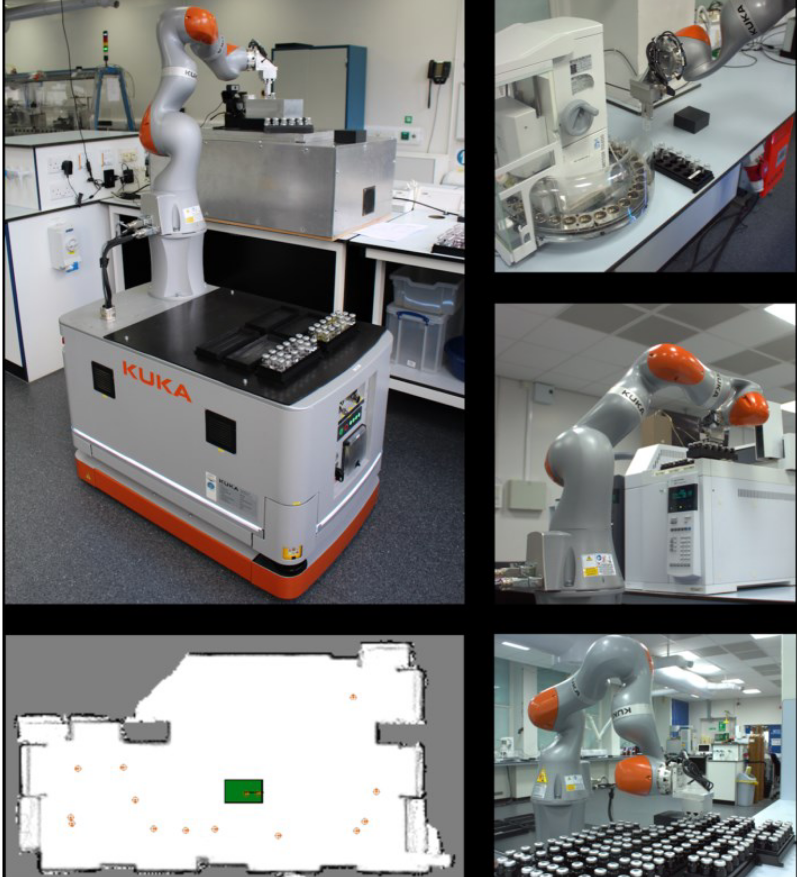Burger, Benjamin and Maffettone, Phillip M. and Gusev, Vladimir V. and Aitchison, Catherine M. and Bai, Yang and Wang, Xiaoyan and Li, Xiaobo and Alston, Ben M. and Li, Buyi and Clowes, Rob and Rankin, Nicola and Harris, Brandon and Sprick, Reiner Sebastian and Cooper, Andrew I. ::: A Mobile Robotic Chemist
Table of Contents
It talks about what robot is used and how the search is performed, how precision is achieved, but little about how skill regarding each station is learnt, and how they are integrated, and how scheduling works. is it by a symbolic reasoning system like NARS or just simple scheduling algorithm with regard to the 6-steps, and primitives like “go to the station 1”, “perform action 1 with station 1, which is at (x,y,theta)”. I guess it’s latter and the artificial intelligence part is more on the search strategy, which looks like bayesian logic, having weighted sum of guess and samples.
1. Paper processed
7 pages of text report + 11 figures
1.1. abstract
- rationale
- task
- search for improved photocatalysts for hydrogen production from water (?oracle?)
- The robot operated autonomously over 8 days, performing 688 experiments within a 10-variable experimental space, driven by a batched Bayesian search algorithm.
- performance
- identified photocatalyst mixtures that were six times more active than the initial formulations, selecting beneficial components and deselecting negative ones
- method
1.2. method
1.2.1. experimental stations
- a 6-step workflow with 6 stations
- all station connected to a centeral controll software, which is also connected to the robot system
1.2.2. auto experiment routine
- experiment in batch of 16 samples
- parallel - when one station is cooking, go start another patch. 6 batch at once max, 2 batch at once in practice
- charged and idle for 32% of the time -GC analysis is slow
2. sementic regrouping
2.1. the problem
2.1.1. in term of chemistry lingo
which I do not understand
2.1.2. in term of search
with an oracle(or bunch of oracles that are the lab anlysis stations), to search for a blend recipe of 10 components that have a global maxima of some analysis result(from an oracle)
2.1.3. in term of lab tasks
2.1.4. how the variable space is form
5 hypothesis
2.1.5. experimental stations
- a 6-step workflow with 6 stations
- all station connected to a centeral controll software, which is also connected to the robot system
2.1.6. parallel auto experiment routine
- experiment in batch of 16 samples
- parallel - when one station is cooking, go start another patch. 6 batch at once max, 2 batch at once in practice
- charged and idle for 32% of the time -GC analysis is slow
2.2. results
2.2.1. useful
Interesting scientific conclusion/insights could be drawn
2.2.2. fast
- AMRC: fast in opereation
- AMRC: fast overall which includes
- time to transfer the workflow to another problem
- time to implement the (transfered) workflow
- time to operate the search
2.2.3. limitations
2.3. method
2.3.1. the robot system ATTACH
- mobile robot
a KUKA mobile robot platform

- human-like dimension and reach
- precise localisation in the lab environment (position +- 0.12mm, orientation +-0.005 degrees)
- operate for upt o 21.6 h per day
- sensors
- laser scanning
- touch feedback
- a platform that moves around
- a robot arm that can grip every thing
2.3.2. robot navigation
- a simultaneous localisation and mapping process (low precision for moving around the stations) (~10mm)
- laser sensors -> position clouds -> map out the positions with x,y,theta
- [high precision for gripping stuff] touch-sensitive 6-point calibration method (~0.12mm) touch 6-points of the cube of the experiment station -> place and orientation of the cube relative to robot
2.3.3. how does robot know
2.3.3.1. identify each experimental station
2.3.3.2. what each experimental station do and their place in the search/experiment routine
2.3.3.3. where they are on the map
2.3.4. the search
They put what looks like an educated search algorithm to the experiment design part of the robot.
- bayesian optimization into photocatalysis experiment workflow in a 10-dimensional space (10 handles to adjust;
1:1:1:1:1:1:1:1:1:1)
2.3.5. conditional automation
double checking hits
3. One hour to read this ariticle
- timer
- I set a 60m timer with KClock
- aim
- a 2-level simulation - I have a full taxonomy with zettels linked from here, and all of them will be simulated, but not all of their links.
Backlinks
(2024 > 04 - April > )
in 04/03/24 to 04/04/24, created 14 nodes
- works to copy
- .dir-locals.el
- emacs async
- injection and projection
- alist
- zenity dialog box
- multiple server in one bash script
- emacs in batch
- Tag and link: Gate and corridor
- Burger, Benjamin and Maffettone, Phillip M. and Gusev, Vladimir V. and Aitchison, Catherine M. and Bai, Yang and Wang, Xiaoyan and Li, Xiaobo and Alston, Ben M. and Li, Buyi and Clowes, Rob and Rankin, Nicola and Harris, Brandon and Sprick, Reiner Sebastian and Cooper, Andrew I. ::: A Mobile Robotic Chemist
- zettelkasten softwares
- activity watch
- custom activity watch rules set
- 2-level simulation